Fine art is one of the activities that is used in children to develop artistic thinking and fine motor skills. Teachers of additional education recommend using non-traditional drawing techniquesSuch methods include monotype and finger painting.
What is monotype?
Monotype is a type of graphic image in fine art, which has become widespread as a unique drawing technique. The author of the technique is considered to be the Italian engraver Giovanni Castiglione.
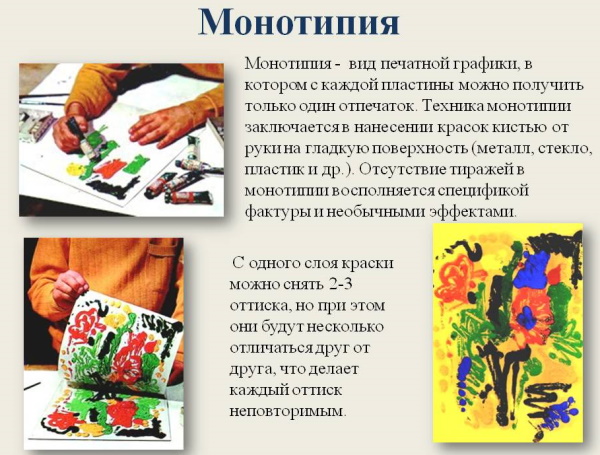
Monotype became known in Russia thanks to the artist Elizaveta Kruglikova. Elizaveta mastered the techniques of monotype when she studied in Paris.
The basis of the technique is the creation of a print. The artist applies a drawing to a special plate using a brush or stencil. Then a sheet of paper is placed on it. The result of the work is an original image that cannot be replicated.
When using professional equipment, the print from the metal plate is bright and high-quality. The plate can be used several times after cleaning from paint.
Since the 90s of the 20th century, monotype has been widely used in psychology and pedagogy to develop artistic perception of various objects in older and younger preschool children. Despite the fact that monotype is classified as a printing technique, it differs significantly from other types, such as engraving, lithography or woodcut.
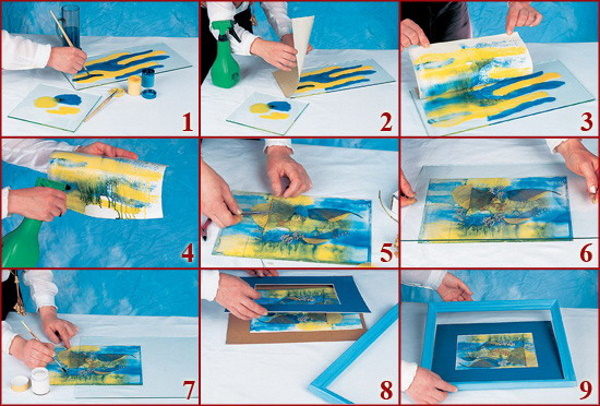
The main difference is the uniqueness of the image obtained by applying paint to the base and creating a print. The result of working in the monotype technique for children is obtaining a watercolor drawing on wet paper.
Monotype has been used as a psychological tool since the 1920s. Swiss psychotherapists used monotype images to test and study personality.
Patients were offered drawings made by imprinting from a metal plate. They had to guess what object was taken as the basis of the imprint. Over time, this approach became widespread in official pedagogy and psychology. This method was used to study the age characteristics of children.
Specialists in the field of additional education for children began to use techniques of monotypic depiction of an object for various purposes:
- to develop artistic skills;
- to teach the basics of drawing;
- to form a spatial representation of objects, their shape and color.
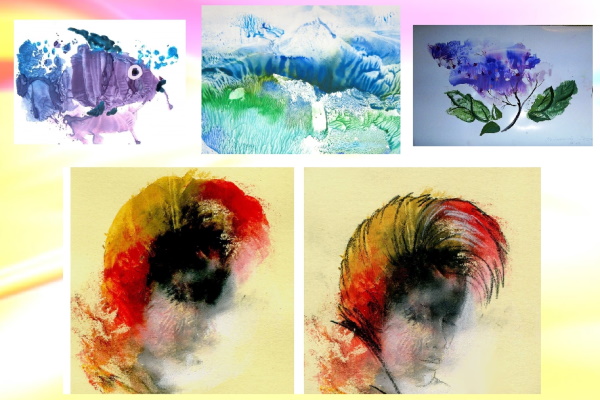
The advantages of using monotype in children's drawing classes are considered to be the following properties:
- development of fine motor skills;
- development of creative thinking;
- speech development;
- stabilization of the emotional background;
- normalization of the nervous system;
- work on important skills necessary for further studies (perseverance, persistence, attentiveness);
- understanding the shapes of objects;
- awareness of a new skill;
- working on differences in color shades.
Features of this drawing technique
Monotype is a drawing technique for children that is used in accordance with generally accepted standards. All children without exception enjoy creating original drawings.
The process of discussing the results obtained with the teacher allows the child to develop spatial thinking, develops imagination and at the same time helps formulate and express thoughts.

Features and description of the method:
- the image is applied to a smooth surface, then transferred to a clean sheet of paper;
- additional objects or devices are used to create the imprint;
- when using this method, much depends on the thickness of the paint, its texture and quality;
- The result may depend on the type of base used, as well as on the child's ability to add details to the created drawing and create an image in accordance with the intended scenario.
Features of the preparatory stage
Monotype (a drawing technique for children) is widely used in kindergartens during fine art classes. Preschoolers learn the skills to implement tasks set by the teacher, and then begin independent work.
The preparatory stage of each lesson is especially important for those who are just beginning to master this technique. First, it is necessary to find out what type of technique the drawing will belong to. An important stage is explaining to the child the principle of constructing his activities.
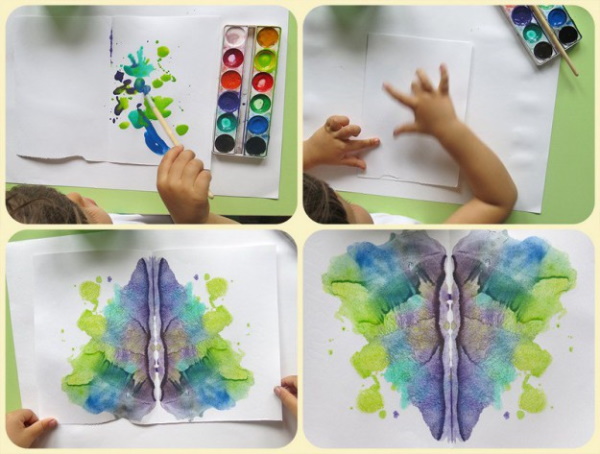
Those who find it difficult to create images on paper on their own are offered to use special stencils at the initial stage. This technique helps children gain confidence in their own abilities and begin to implement their own creative plans.
Materials for work
When preparing for classes, you should choose the right materials. Beginners are recommended to use gouache for work. Those children who have mastered the initial skills can easily reproduce prints using watercolor paints, changing the saturation and density.
When preparing for the lesson, it should be taken into account that children should be offered images of familiar objects as the main scenarios. It is important to consider the shape of the objects being depicted, the color scheme, and also to monitor the process of the child applying paint to the paper.

The technique of creating a drawing involves the use of special materials:
- Warp. As a base, it is recommended to use thick paper that is not soaked with applied paints. Cardboard or drawing paper are well suited for this. When using alternative techniques, it is recommended to use metal or glass surfaces, plastic boards for modeling, and various tiles with unusual textures.
- Paints. For children, it is recommended to select a set of gouache in 6 or 10 colors, finger paints or watercolors.
- Drawing accessories. To create contours, patterns, and various prints, brushes of varying degrees of hardness, cotton swabs, toothpicks, seals, and rubber tubes are used.
- Auxiliary materials. Plywood, various types of cardboard, and thick textured fabric are used as a base for the painting onto which the resulting images are transferred.
Monotype techniques
Monotype is a drawing technique based on various techniques. When working with children, it is common to use basic methods. There are several types of monotype. They are distinguished by the use of techniques and tools.
Subject
The method is based on an image of an object familiar to the child. To obtain the desired result, it is necessary to explain to the child the importance of following step-by-step instructions.
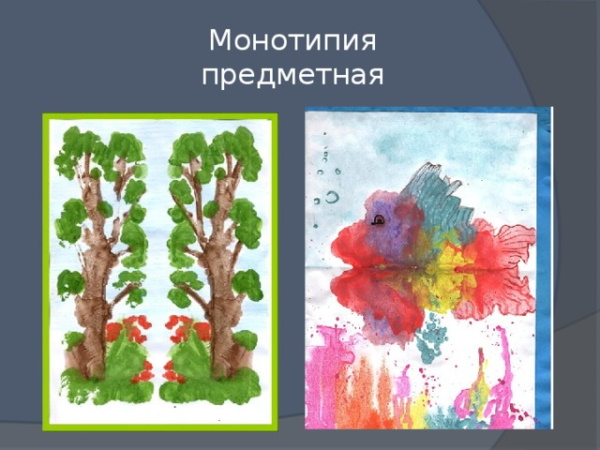
When using the subject technique, the drawing is done on one side of a clean sheet of paper. Before starting work, the sheet is folded in half. The object is drawn in such a way that part of the object is on one side of the sheet.
This method helps to master the principle of symmetry. On the second side of the sheet after the imprint, a symmetrical image of a part of the object appears.
After folding the sheet along the intended fold, a complete image appears. This technique demonstrates the essence of the method to children and helps develop spatial thinking. This is necessary in order to obtain a result as close as possible to the intended one.
The child's task is to create a clear outline of the object on one side of the sheet with the necessary density and saturation of gouache. The teacher's task is to help the child carefully make an imprint to obtain a drawing with clear outlines and borders.
For preschoolers at the initial stage, we recommend subject monotypes with images of balloons, squares or objects with a clear geometric shape.
Landscape
Landscape type of monotype is the most spectacular and popular technique. A striking example of landscape technique is the image of a forest. The result of the print is the display of a forest on a water surface.
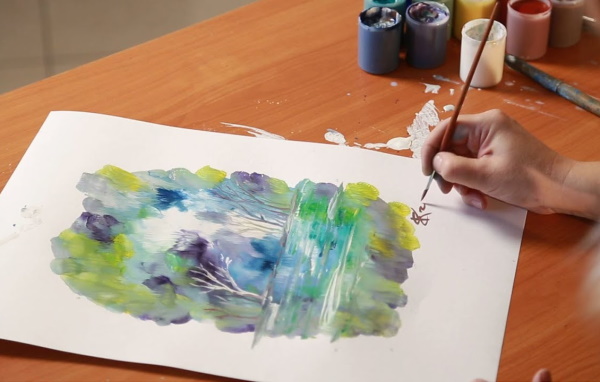
This landscape can be created by folding a thick sheet of paper in half horizontally. The bottom part should be smaller than the top part. Trees are drawn on the top part of the sheet.
The artistic idea behind this technique is that the trees should rise above the surface of the pond. The landscape that results from joining the top and bottom of the sheet imitates the reflection of the forest in the water. Children really enjoy creating pictures with reflections in the water.
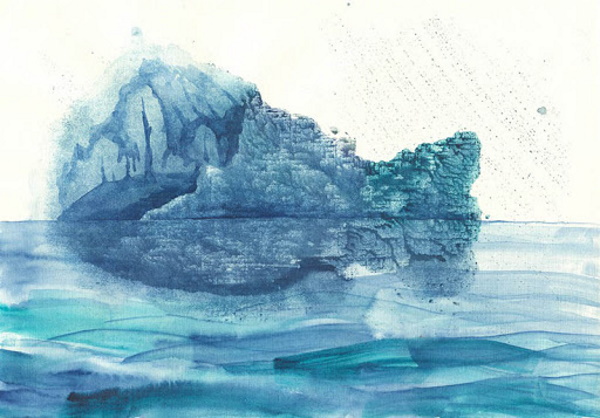
Drawing technique for children allows creating landscapes of any complexity. On the shore of a reservoir, single trees, various buildings are depicted, animals or people are drawn. Drawing details depends on the skill and development of the child's abilities.
The peculiarity of the technique is that after folding the two parts of the sheet together, the water surface is drawn additionally. The better the surface is drawn, the more reliable the result looks.
Alternative techniques
There are several variations of the monotype technique that are used in drawing classes using auxiliary elements.
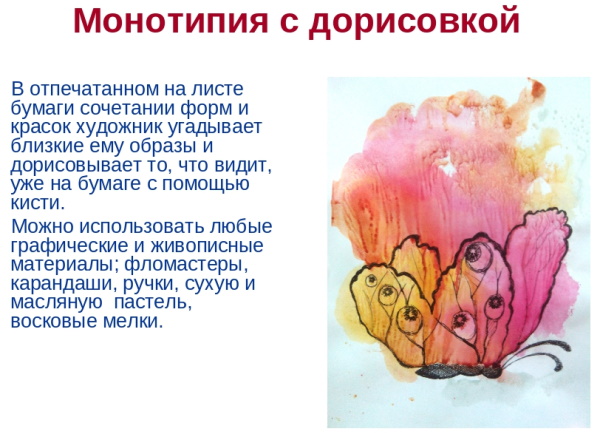
| Type of monotype | Description | Necessary tools |
| Abstraction | The textured plastic surface is painted over with a single-color paint, a sheet of paper is applied to the surface, then carefully removed, starting from the far edge. | A plastic tray or board for working with plasticine |
| Fixing the drawing | Paint is applied to a sheet of paper in any order, then the multifora is pressed against the drawing, and both surfaces are crumpled. After the sheet has straightened, the plastic bag is removed. The paper produces a drawing with streaks that imitate snowdrifts. | Multifora, polyethylene bag |
| Creating a pattern | On a sheet of paper, draw different patterns with a cotton swab or toothpick, then make an imprint. The result of the work is an image of a snow surface with different patterns. | Cotton swabs, toothpicks |
Work options
Monotype is a drawing technique for children that involves using standard scenarios as examples. Children in kindergarten classes often draw based on the provided examples. The degree of complexity of the drawing depends on the child's skills and abilities.
Butterfly
A butterfly is one of the simplest drawings. Drawing a butterfly demonstrates to children the essence of the method and allows creating colorful works in the subject technique.
For painting, gouache of bright shades is used.
Step by step instructions:
- A sheet of thick A4 or A5 paper is folded in half.
- In the center, outline the butterfly's abdomen with black gouache.
- On one side, the child is asked to draw butterfly wings using several colors. On each part of the wing, patterns, stains, and ornaments are drawn.
- After completing the drawing, the sheet is folded again along the fold line.
- To create a clear imprint, use a roller.
- Then the sheet is carefully unfolded in one motion.
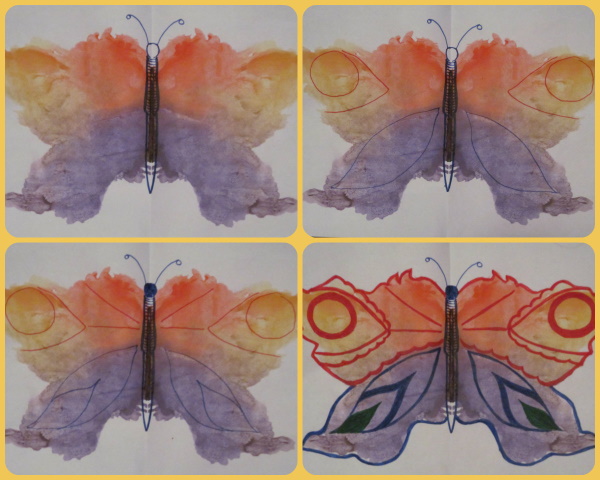
Children who have long been familiar with the monotype technique are asked to make an outline with a thin brush or felt-tip pen after the paint has completely dried. The butterfly drawing is supplemented with an image of antennae and other details.
Tree
The tree can be depicted in the subject or landscape technique. In the first case, the sheet of paper is folded vertically, in the second case, the sheet is folded horizontally.
The subject technique involves depicting one part of the tree from the right or left side of the fold. The trunk is schematically depicted with a pencil, then the branches and leaves are drawn. After the print, a whole tree is obtained. Details are added as needed.
The landscape technique involves creating an image that seems to be reflected in the water surface. The tree is drawn completely, using available colors. Then the sheet is folded again along the fold line.
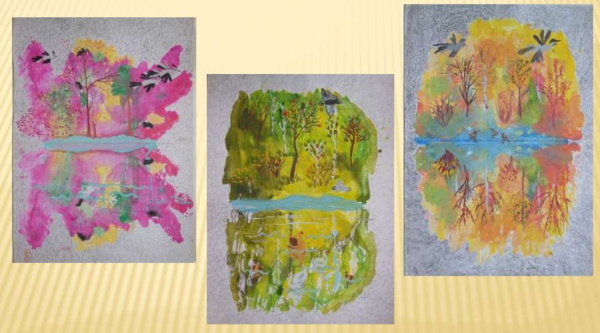
After receiving the print, draw the water, adding the necessary paints. When using the landscape technique to obtain a mirror reflection, you do not need to use a roller. When creating a print, it is necessary to achieve a blurry water reflection.
Winter landscape
Drawing a winter landscape is one of the options for developing creative thinking in children. The image of snow cover, snowfall or trees in winter can be created using various tools.
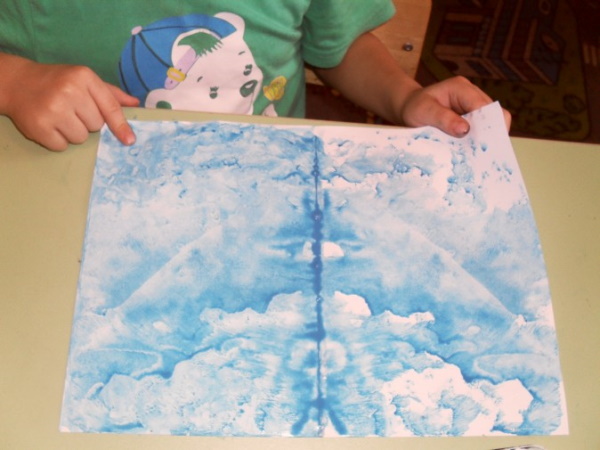
| Type of work | Description |
| Option 1 | A light blue or blue background is drawn on a glass or plastic surface. Smudges and patterns are made with a cotton swab. A thick sheet of white paper is placed on the wet drawing. After the result is obtained, the image is sprinkled with silver glitter. |
| Option 2 | Blue snow and white clouds are drawn on a thick sheet of paper. The sheet of paper is crumpled, paint accumulates in the center of the folds, where the background becomes lighter. After the paint dries, the sheet is straightened. |
| Option 3 | A thick sheet of paper is folded horizontally. White and blue clouds are drawn on the top. After that, an imprint is made on the bottom using a roller. The result is an image of a winter sky and snow cover. |
Winter landscapes can be supplemented with snowflakes using a brush and white gouache. To make the drawing brighter, use silver glitter and glue rhinestones.
Vase with flowers
Monotype is a drawing technique for children that involves using traditional themes. A vase of flowers is one of the themes offered in classes for younger students. This type of image requires special skills, but at the same time it is quite simple.
A vase with flowers is drawn according to the subject type. On the right side of the sheet, a part of a vase and several flowers are depicted. The flowers are drawn so that the stems rise above the surface of the vase by 2 times. After the imprint, the contours are corrected with a brush, creating clear boundaries between each flower in the vase.
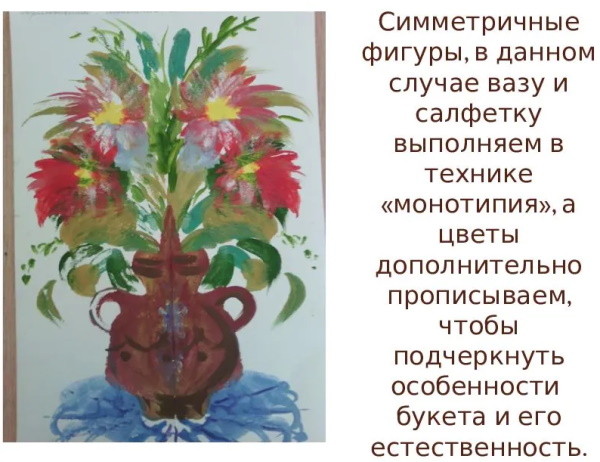
One of the options is to create a drawing with smooth transitions, in which the image of a vase with flowers is guessed by its characteristic features. To do this, a sheet of thick paper is painted with white gouache. On a white background, the outlines of a dark-colored vase and the contours of flowers in bright shades are drawn.
To blur the contours, take cotton swabs or brushes with hard bristles. Cover the image with a sheet of white paper, roll it over and carefully remove the top image. To create clear boundaries, use brushes and contour.
Monotype is a unique drawing technique. It is used in classes with children as a technique that develops creative thinking. At the same time, children develop spatial thinking, activate thought processes, strengthen the skill of perseverance, and develop the ability to formulate their own thoughts.
Video about monotype technique
Monotype painting with children:
